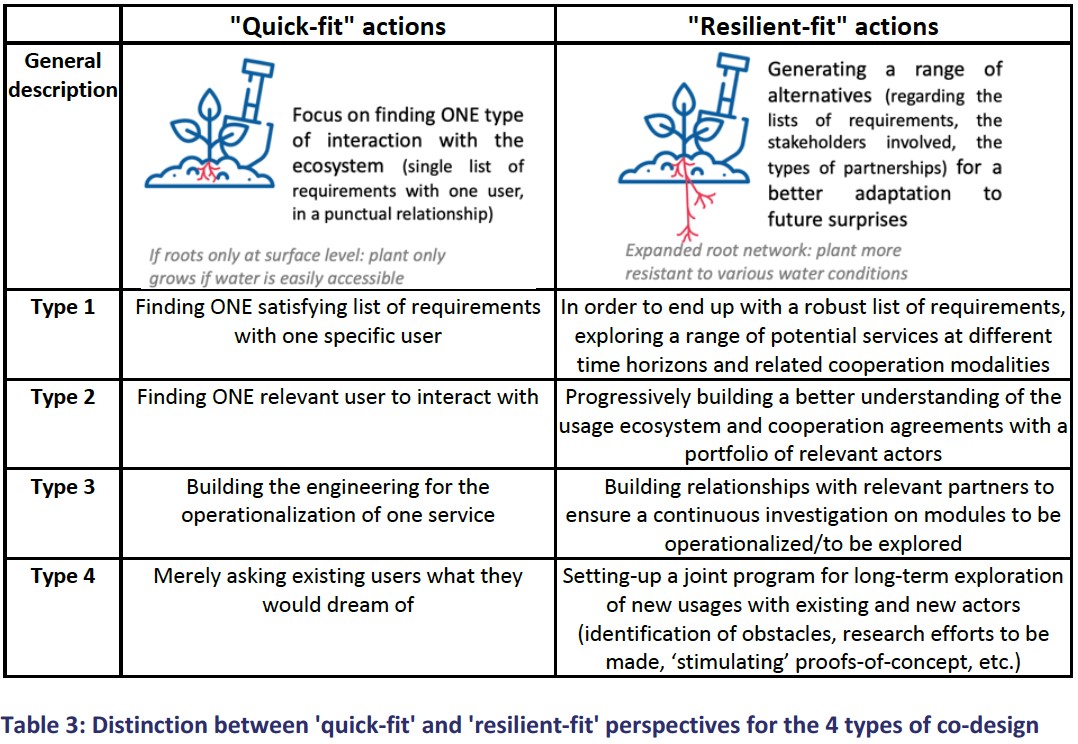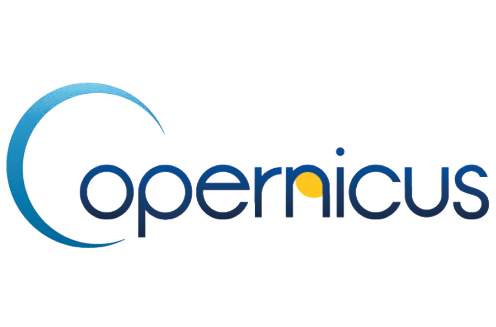Co-design
With and For users
Highlights of co-design methodology
Initially produced mainly for scientific goals, EO data are now made available to every economic actor, through ‘open-data’ policies. Socio-economic applications of this data seem to be diverse and promising for a large variety of socio-economic stakeholders: research communities, but also public authorities, private companies, academia, citizens. However, in practice, developing usages from EO data seems to be particularly challenging.
Indeed, this effort could be schematically described as connecting various and highly heterogeneous socio-economic ecosystems: the ecosystem of Earth-observation data and the various ecosystems of potential usages, that do not share the same dynamics, time horizons (e.g. very long cycles to develop new measuring instruments compared to short timeline of actions in the data usage context), performance logics and competencies (e.g. data processing might require very specific technical expertise while data usages might also require specific domain expertise).
Co-design precisely aims at connecting these various and heterogeneous ecosystems of data and usages, through the development of EO-based services, and support their dynamics in a long-term perspective.
In e-shape, a co-design model considering EO specificities is progressively designed and tested with e-shape pilots, through a dedicated work-package (WP2). A first analytical framework has been built and described in D2.1, D2.2, and D2.3 deliverables (https://e-shape.eu/index.php/resources), especially highlighting that a co-design model adapted to EO context should involve two distinct phases: (1) a critical “diagnosis process” to identify the co-design needs, classified in four main types of co-design, (2) the implementation of co-design actions to address these co-design needs.
Highlight #1: A diagnosis process to help the pilots to better structure their co-design strategy identifying relevant forms of co-design actions at different time horizons.
Based on the analysis of e-shape pilots, a certain variety of co-design needs could be identified, leading us to define four main types of co-design:

In order to carry out the co-design needs analysis meetings, WP2 has developed a grid for analysing the pilots, representing each of them in a so-called ‘data-information-usage’ framework (see Figure 1). The objective of this analysis is to draw up an overall picture of the pilot context and identify the possible blocking points hindering the development of new EO usages. This especially includes the analysis of the data transformation processes (from data sources to a generic form of information that can be used in multiple usage contexts, up to value-embedding usages) and the various stakeholders involved all along this data-information-usage chain. Five main points of analysis have been especially considered, and are represented on Figure 1. See deliverable D2.4. for more details (https://e-shape.eu/index.php/resources).

The 32 pilots of e-shape benefited from this diagnosis phase. This has proved to be particularly helpful for pilots to better structure their development approach, identifying which types of co-design actions would be relevant at which time horizon.
Feedback from S2-P3 pilot: “The co-design diagnosis also was very well structured and the needs on Confluence remembered us to go back and check. It was very good to have short-term and long-term so this helped us to come back couple of months after an see what we had said for the long-term to know what to implement.”
“The co-design diagnosis also was very well structured and the needs on Confluence remembered us to go back and check. It was very good to have short-term and long-term so this helped us to come back couple of months after an see what we had said for the long-term to know what to implement.” (Alexia Tsouni, NOA, showcase 6 coordinator and work package leader)
A first version of a self-diagnosis tool has been developed by WP2 to help e-shape pilots to carry out their own co-design needs diagnosis, consisting in a excel sheet and guiding documents. The tool was used by the last 5 onboarded pilots. From our first observations, it appears that this document is helpful to initiate the diagnosis process, but a telco with WP2 was still required to finalise the analysis. Further work will be needed to improve this first self-diagnosis tool. You can download the excel file here.
Highlight #2: Rigorous protocols to conduct co-design actions ensuring the growth of the EO ecosystem in a resilient perspective
Co-design should be considered as a way of growing an ecosystem of efficient EO-based service designers. It is based on a continuous process involving four types of actions aiming at unlocking blocking points occurring in the development of the services. Each co-design type has specific co-design action(s):
- Co-design type 1 workshops organize the dialogue between the pilot and the users in a specific way in order to establish adapted relationships with these specific users and to overcome fixation effects;
- Co-design type 2 workshops consist in confronting the service to different contexts (decided by the pilot in the preliminary phase) with users. The topic of each workshop can be formulated as follows: exploring the range of usefulness of the pilot’s service and related actors of the ecosystem by leveraging the knowledge & experience of the participants to the workshop.
- Co-design type 3 action is a sequence of workshop sessions with pilot partners to progressively refine and update a common understanding of the service structure (modules to be operationalized/to be further explored), and the related cooperation modalities on each type of modules.
- Co-design type 4 action should be a cycle of workshops with users that consist in a joint exploration with the help of existing users to explore a range of perspectives for the development of future usages - either new usages for existing users or for others (supporting the evolution of the usage ecosystem in certain directions).
Co-design type 4 workshops hasn’t been fully formalized and tested yet.
Each workshop is designed to progressively shape and consolidate ‘building blocks’ of the long-term development of the pilot’s strategy, intertwined with the evolution of both EO and usage fields. Based on the experimentations carried out in e-shape, two dimensions appear as particularly critical for the success of co-design actions in a long-term perspective:
- Each action should not only focus on the specifications on the EO-based solution, but should also include the design of a certain committed form of relationship (designing the ‘co’);
- Each action should aim at establishing a ‘resilient fit’ between relevant stakeholders, in order to make sure that these efforts are sustainable over time, rather than a quick-fit.‘
- Quick-fit’ actions would focus on finding one type of interaction between data and usages ecosystems (single list of requirements with one user, in a punctual relationship).
- Whereas, ‘resilient-fit’ actions aim at generating a range of alternatives (regarding the lists of requirements, the stakeholders involved, the types of partnerships), allowing a better adaptation to future surprises or unexpected constraints.

A specific protocol has been designed for each type of co-design action, and has already been experimented for co-design type 1, 2 and 3. Thanks to this experience, WP2 was able to develop a user guide for each of the three first types of co-design actions. This will allow the pilots who did not ask for WP2's help to follow the WP's recommendations as well as possible in order to reach a "resilient-fit" or to have material to better manage their activities. Each user guide consists of a folder with 2 templates (workshop and formalization of outcomes) and a folder with the same documents but filled with information to show the example to follow.
For further details on protocols please refer to D2.4 and D2.5 deliverables following this link: https://e-shape.eu/index.php/resources
Based on the workshops carried out so far, the results appear as promising. Here are some testimonies of people who participated in the workshops:
- Feedbacks from S2-P3 pilot: “The initial co-design workshop proved to be an immense success […]. Beyond providing a forum for this initial discussion of the list of requirements from these users and an introduction to the HSAQ Pilot and co-design process, the workshop served as a means to formalize relationships and find synergies between workflows and users, propelling us to officially pursue partnering with National Public Health Organization and the Ministry of Energy and the Environment to discuss and share data, and contribute to the development of a national health observatory.” (Evangelos Gerasopoulos, NOA, pilot leader)
- Feedbacks from S3-P3 pilot: “For me it was really eye opening that we could use it in such a broad way to look at all sort of possibilities rather than trying to narrow down what we wanted to do. It was more about broadening out and gathering lots of ideas and inputs.” “In particular, it was beneficial to understand that co-design is not just about convincing a user to adopt a product or service. The main purpose is to get a better understanding of the ecosystem.” (Merete Badger, DTU, pilot leader)
Feedbacks from S3-P2 pilot: “This exercise has proved to be useful as in 3h we have structured our working plan for the next 6 months in a clear way.” (Etienne Wey, Transvalor, member of S3-P2 pilot) “We learnt a lot definitely. It’s something which dealt with some tremendous unknown things that we learnt by talking to you [i.e. WP2 team] through this process” (Lionel Ménard, O.I.E., member of S3-P2 pilot)
Highlight #3: Advancing academic research in design and innovation management
The development of the co-design method in e-shape also brings significant contributions to research in design and innovation management, especially investigating the specificities of a data-based regime of design, that would ensure the growth of a data-based ecosystem supporting multiple actors of various sectors in tackling grand challenges. This has resulted so far in several academic publications and communications in conferences, listed below:
- Raphaëlle Barbier, Benoit Weil, Pascal Le Masson, "Creating value from data in an ecosystem: building and expanding relationships between data and seemingly distant usages"; R&D Management 2019
https://hal-mines-paristech.archives-ouvertes.fr/hal-02168086
- Raphaëlle Barbier, Skander Ben Yahia, Pascal Le Masson, Benoit Weil "Expanding Usages οf Earth Observation Data: A Co-design approach to grow an ecosystem of efficient service designers"; International Geoscience and Remote Sensing Symposium (IGARSS) conference
https://hal.archives-ouvertes.fr/hal-03356299/document
- Raphaëlle Barbier, Pascal Le Masson, Benoit Weil, "Transforming Data Into Added-value Information: The Design Of Scientific Measurement Models Through The Lens Of Design Theory"; nternational Conference on Engineering Design, ICED21
- Raphaëlle Barbier, Pascal Le Masson, Sylvain Lenfle, Benoit Weil, "Building the generativity of data to support the dynamics of multiple ecosystems: the case of Earth-observation data", R&D Management conference 2021
Stay in the loop !
Acknowledgment
The e-shape project has received funding from the European Union’s Horizon 2020 research and innovation programme under grant agreement 820852





